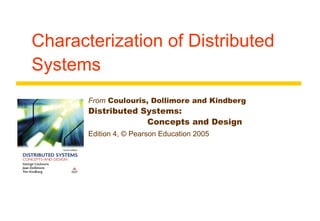More Related Content
Similar to Chapter 1 characterisation of distributed systems
Similar to Chapter 1 characterisation of distributed systems (20)
More from AbDul ThaYyal (11)
Chapter 1 characterisation of distributed systems
- 1. Characterization of Distributed
Systems
From Coulouris, Dollimore and Kindberg
Distributed Systems:
Concepts and Design
Edition 4, © Pearson Education 2005
- 2. Networking and Parallel Computing
Computer networking
Hardware that connects computers
Software that sends/receives messages from one
computer to another, which might be on different networks
(end to end delivery)
Goal is to transmit messages reliably and efficiently
Parallel Computing
Multiple homogeneous processors in “one” computer
Shared or distributed memory
Goal is to execute a program faster by division of labor
Coulouris, Dollimore and Kindberg
Distributed Systems: Concepts and Design
Edn. 4
© Pearson Education 2005
- 3. Distributed Computing
Networked computers that could be far apart
rely on computer networking
Communicate and coordinate by sending messages
Goal is to share (access/provide) distributed
resources
Issues:
Concurrent execution of processes
No global clock for coordination
More components, more independent failures
Coulouris, Dollimore and Kindberg
Distributed Systems: Concepts and Design
Edn. 4
© Pearson Education 2005
- 4. Examples of Distributed Systems
Global Internet
Organizational Intranets--behind router/firewall
Mobile Computing -- computers move
Ubiquitous Computing -- computers embedded
everywhere
Issues:
discovery of resources in different host environments
dynamic reconfiguration
limited connectivity
privacy and security guarantees to the user and the host
environment
Coulouris, Dollimore and Kindberg
Distributed Systems: Concepts and Design
Edn. 4
© Pearson Education 2005
- 5. A Typical Portion of the Internet
intranet
Coulouris, Dollimore and Kindberg
Distributed Systems: Concepts and Design
Edn. 4
© Pearson Education 2005
ISP
desktop computer:
backbone
satellite link
server:
network link:
- 6. A Typical Intranet
Web server
Coulouris, Dollimore and Kindberg
Distributed Systems: Concepts and Design
Edn. 4
© Pearson Education 2005
the rest of
email server
Desktop
computers
File server
router/firewall
print and other servers
print
other servers
Local area
network
email server
the Internet
- 7. Portable and handheld devices
Mobile
Laptop
Coulouris, Dollimore and Kindberg
Distributed Systems: Concepts and Design
Edn. 4
© Pearson Education 2005
Printer
Camera
Internet
Host intranet WAP Home intranet
Wireless LAN
phone
gateway
Host site
- 8. Resource Sharing and the Web
HTML, Hyper Text Markup Language
URL, Uniform Resource Locator
http://servername[:port] [/pathname] [?arguments]
HTTP, HyperText Transfer Protocol
request-reply protocol (client-server)
content types--MIME types, multipurpose internet mail
extensions
one resource per request
simple access control (mostly public)
Coulouris, Dollimore and Kindberg
Distributed Systems: Concepts and Design
Edn. 4
© Pearson Education 2005
- 9. Web Servers and Web Browsers
www.google.com
http://www.google.comlsearch?q=kindberg
Web servers Browsers
Internet
www.cdk3.net
www.w3c.org
Protocols
Activity.html
http://www.cdk3.net/
http://www.w3c.org/Protocols/Activity.html
Coulouris, Dollimore and Kindberg
Distributed Systems: Concepts and Design
Edn. 4
© Pearson Education 2005
File system of
www.w3c.org
- 10. Other Web Technologies
web forms
CGI programs, common gateway interface, run on
the server
applets, run on the client
RDF, resource description framework, vocabulary for
meta-data
XML, extensible markup language, allow meta-data
information to be included
Coulouris, Dollimore and Kindberg
Distributed Systems: Concepts and Design
Edn. 4
© Pearson Education 2005
- 11. Computers in the Internet
Date Computers Web servers
1979, Dec. 188 0
1989, July 130,000 0
1999, July 56,218,000 5,560,866
2003, Jan. 171,638,297 35,424,956
Coulouris, Dollimore and Kindberg
Distributed Systems: Concepts and Design
Edn. 4
© Pearson Education 2005
- 12. Computers vs. Web servers in the Internet
Date Computers Web servers Percentage
1993, July 1,776,000 130 0.008
1995, July 6,642,000 23,500 0.4
1997, July 19,540,000 1,203,096 6
1999, July 56,218,000 6,598,697 12
2001, July 125,888,197 31,299,592 25
42,298,371
Coulouris, Dollimore and Kindberg
Distributed Systems: Concepts and Design
Edn. 4
© Pearson Education 2005
- 13. Challenges and Issues (1)
Heterogeneity
networks, hardware, os, languages...
middleware—corba
mobile code, virtual machines
Openness
extended and re-implemented in various ways
standard published interfaces
RFC, request for comments
Coulouris, Dollimore and Kindberg
Distributed Systems: Concepts and Design
Edn. 4
© Pearson Education 2005
Security
confidentiality
integrity
availability
- 14. Challenges and Issues (2)
Scalability
effective with significant increase in resources
cost
performance
Failure handling
detecting
masking—hide, less severe (retransmit)
tolerating--ignore, timeout
recovery--logs, rollback
Redundancy
Coulouris, Dollimore and Kindberg
Distributed Systems: Concepts and Design
Edn. 4
© Pearson Education 2005
Concurrency
- 15. Challenges and Issues (3)
Transparency
Access transparency: enables local and remote resources
to be accessed using identical operations.
Location transparency: enables resources to be accessed
without knowledge of their physical or network location (for
example, which building or IP address).
Concurrency transparency: enables several processes to
operate concurrently using shared resources without
interference between them.
Replication transparency: enables multiple instances of
resources to be used to increase reliability and
performance without knowledge of the replicas by users or
application programmers.
Coulouris, Dollimore and Kindberg
Distributed Systems: Concepts and Design
Edn. 4
© Pearson Education 2005
- 16. Challenges and Issues (4)
Transparency
Failure transparency: enables the concealment of faults,
allowing users and application programs to complete their
tasks despite the failure of hardware or software
components.
Mobility transparency: allows the movement of resources
and clients within a system without affecting the operation
of users or programs.
Performance transparency: allows the system to be
reconfigured to improve performance as loads vary.
Scaling transparency: allows the system and applications
to expand in scale without change to the system structure
or the application algorithms.
Coulouris, Dollimore and Kindberg
Distributed Systems: Concepts and Design
Edn. 4
© Pearson Education 2005

